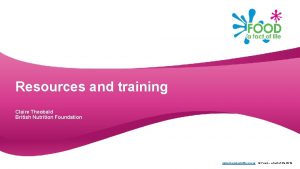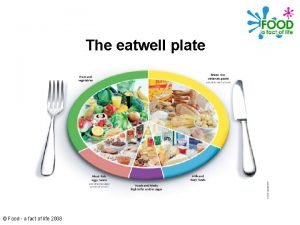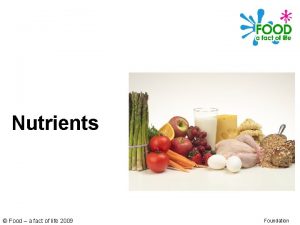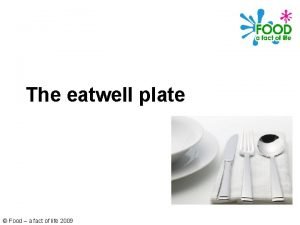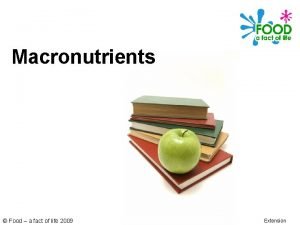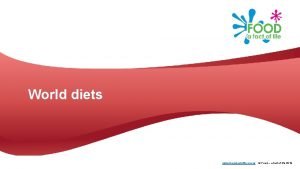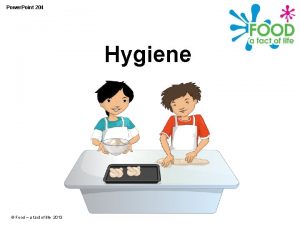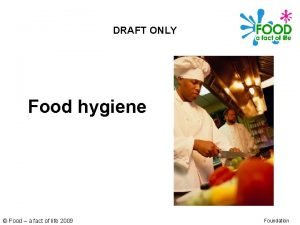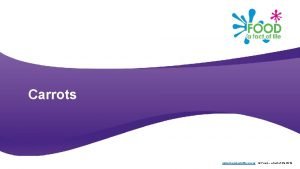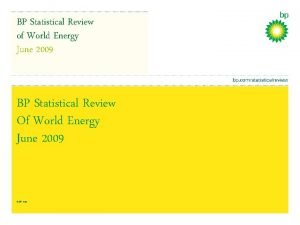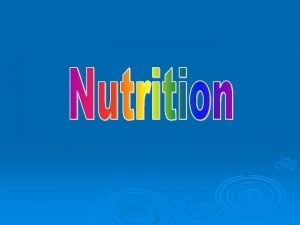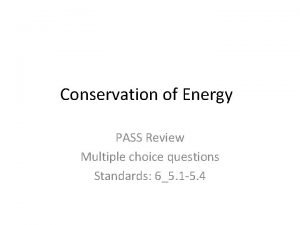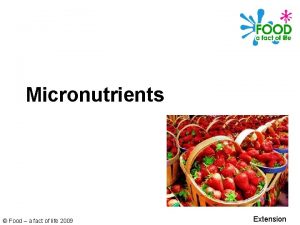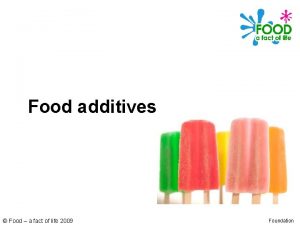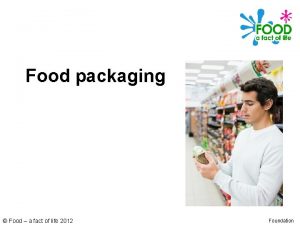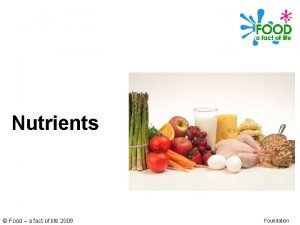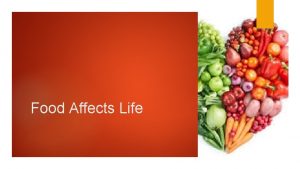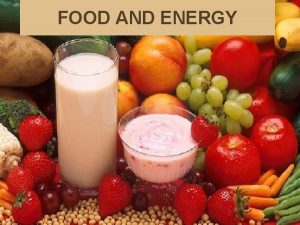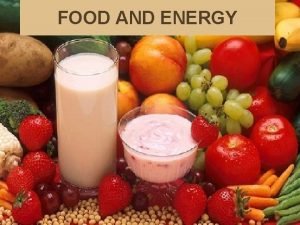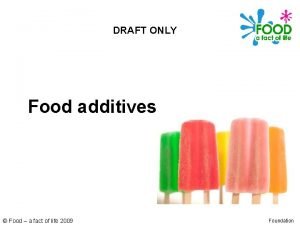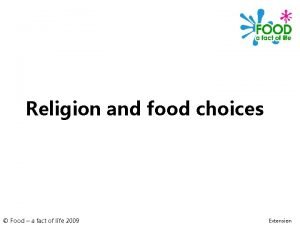Energy Food a fact of life 2009 Extension



































- Slides: 35

Energy © Food – a fact of life 2009 Extension

Learning objectives • To define energy and explain why it is needed. • To identify sources of energy in the diet. • To understand how energy needs change throughout life. • To understand the energy needs of different activities. • To define energy balance. • To explain problems associated with energy imbalance. © Food – a fact of life 2009

What is energy? Energy is the power used to do work or to produce heat or light. Energy cannot be created or destroyed, but can be changed from one form to another. It is measured in kilojoules (k. J) or megajoules (MJ). When using imperial measurements, kilocalories (kcal) are used. 1 k. J = 1000 J 1 MJ = 1000 k. J 1 kcal = 1000 cal 1 kcal = 4. 18 k. J © Food – a fact of life 2009

Energy from food When we consume food and drink, energy provided by carbohydrate, protein, and fat (and alcohol) is metabolised and used by our bodies. Carbohydrate, protein, and fat (and alcohol) are broken down into smaller compounds which are then oxidised in the cells of the body (respiration). © Food – a fact of life 2009

Energy Balance © Food – a fact of life 2009

Energy intakes Experts have estimated the average requirements for energy for different types of people. These figures are known as Estimated Average Requirements (EAR) for energy. Experts also recommended that: • about 50% of our energy intake should come from carbohydrate; • no more than 35% of our energy intake should come from fat; • about 15% of our energy intake should come from protein. © Food – a fact of life 2009

Energy intakes The average energy intake in the UK for young people aged 15 - 18 years is: • 8830 k. J for girls. • 11510 k. J for boys. However, requirements vary from person to person depending on a variety of factors, including physical activity level. © Food – a fact of life 2009

Energy expenditure Different people need different amounts of energy, depending on a variety of factors, including their: • • • basal metabolic rate (BMR); level of physical activity; age; sex; body size. © Food – a fact of life 2009

Basal metabolic rate The basal metabolic rate (BMR) is the rate at which a person uses energy to maintain the basic functions of the body e. g. breathing. BMR is measured when a person is at complete rest, and varies between person to person. Men usually have a higher BMR than women because they tend to have a larger muscle mass. The BMR accounts for 75% of an individual’s energy needs. © Food – a fact of life 2009

Activity levels The total amount of energy required by an individual depends on their level of activity. The more active an individual is, the more energy they need. © Food – a fact of life 2009

Being active everyday It is recommended that children and young people participate in at least 60 minutes of moderate intensity everyday where breathing rate and heart rate increase. Activities that increase muscle strength and flexibility as well as bone strength, should also be included once a week. Regular activity will help maintain energy balance. © Food – a fact of life 2009

Energy needs of children Infants and children have relatively large energy requirements because they are active and growing. Infants and young children have a higher BMR in relation to their size because energy is needed for growth. © Food – a fact of life 2009

Energy needs of adolescents Adolescents have high energy requirements due to the body changes they experience from 11 -18 years of age. They are also often very active. © Food – a fact of life 2009

Energy needs of adults (19 -50 years) Adult energy requirements are lower than those of adolescents. However, during pregnancy and lactation (breastfeeding) there is an increased need for energy for the growing fetus and milk production. © Food – a fact of life 2009

Energy needs of adults 50 years and over Energy requirements decrease gradually after the age of 50 years in women and 60 years in men. It is advisable that older people consume food and drinks that are low in energy but high in vitamins and minerals to meet their requirements. These foods are known as nutrient dense foods. © Food – a fact of life 2009

Energy balance To maintain body weight it is necessary to balance the energy derived from food with that expended in activity. Energy balance is achieved when energy intake equals energy expenditure. It is important to maintain a healthy weight or avoid becoming overweight or underweight, both of which are major public health problems in the UK. © Food – a fact of life 2009

Positive energy balance When the diet provides more energy than is needed, it is stored as fat and the person puts on weight over time. People who are in positive energy balance over an extended period of time (i. e. they take in more energy than they use) are likely to become overweight or obese. © Food – a fact of life 2009

Overweight and obese Excess energy is stored in adipose tissue and can build up if energy intake continues to be too high, or activity levels remain too low. Being overweight or obese is associated with an increased risk of developing certain cancers, cardiovascular disease and type 2 diabetes. © Food – a fact of life 2009

Negative energy balance A person is said to be in negative energy balance when there is insufficient energy from the diet to meet energy demands of the body. Energy is derived from energy stores and the person looses weight. People who achieve a negative energy balance over an extended period of time, are likely to become underweight. © Food – a fact of life 2009

Underweight When too little energy is consumed over a period of time, the body derives energy from fat stores leading to weight loss. When too much fat is lost, the person becomes underweight. Being underweight is associated with health problems, such as osteoporosis, infertility and heart failure. © Food – a fact of life 2009

© Food – a fact of life 2009

Energy Expenditure © Food – a fact of life 2009

Components of Energy Expenditure © Food – a fact of life 2009

© Food – a fact of life 2009

© Food – a fact of life 2009

Running~14. 1 kcal/min @ 7. 5 mph © Food – a fact of life 2009

Monitoring energy balance For adults, change in weight is a good guide to energy balance. The Body Mass Index (BMI) is a good indicator of whether a person is underweight, overweight or a healthy weight. The BMI range should only be used for people aged 18 years of age and over. We are all encouraged to maintain a healthy weight by balancing energy intake with energy expenditure. © Food – a fact of life 2009

Calculating BMI kg. m 2 Step 1 Height in meters (m) x height in metres (m) Step 2 Divide weight in kilograms (kg) by step 1 Step 3 Equals BMI. Next refer to guide below. OR go the website http: //bmicalculator. cc/ © Food – a fact of life 2009 Recommended BMI range Underweight less than 18. 5 Normal 18. 5 - less than 25 Overweight 25 - less than 30 Obese 30 - 40 Very obese over 40

Calculating BMI Calculate these 3 examples: 1. Samantha 2. Dale 3. Ruth Height: 1. 70 m Height: 1. 95 m Height: 1. 63 m Weight: 51 kg Weight: 82 kg Weight: 78 kg BMI = kg. m 2 © Food – a fact of life 2009 Recommended BMI range Underweight less than 18. 5 Normal 18. 5 - less than 25 Overweight 25 - less than 30 Obese 30 - 40 Very obese over 40

BMI example 1 Samantha Height: 1. 70 m 51 kg. 1. 7 m x 1. 7 m Weight: 51 kg BMI = 17. 6 Samantha is underweight. Recommended BMI range Underweight less than 18. 5 Normal 18. 5 - less than 25 Overweight 25 - less than 30 Obese 30 - 40 Very obese over 40 © Food – a fact of life 2009

BMI example 2 Dale Height: 1. 95 m 82 kg. 1. 95 m x 1. 95 m Weight: 82 kg BMI = 21. 6 Dale is a healthy weight. Recommended BMI range Underweight less than 18. 5 Normal 18. 5 - less than 25 Overweight 25 - less than 30 Obese 30 - 40 Very obese over 40 © Food – a fact of life 2009

BMI example 3 Ruth Height: 1. 63 m 78 kg. 1. 63 m x 1. 63 m Weight: 78 kg BMI = 29. 4 Ruth is overweight. Recommended BMI range Underweight less than 18. 5 Normal 18. 5 - less than 25 Overweight 25 - less than 30 Obese 30 - 40 Very obese over 40 © Food – a fact of life 2009

Basal Metabolic Rate (BMR) • Is basically a calculation that tells you the basic amount of energy that you are expending doing no activity (basically if you lied in bed all day how many calories you would expend) • The BMR is based on your height, weight, age and sex • Go to the link below to calculate your BMR • http: //www. bmi-calculator. net/bmr-calculator/ © Food – a fact of life 2009

Once you have your BMR…. • Click on Daily Calorie Needs link below. • Time for some math!! • To figure out how many calories you need to use the Harris- Benedict method to decide how active you are. • Based on the calculation how many calories do you need to MAINTAIN your current weight? © Food – a fact of life 2009

Your Turn! • So now you know how to read food labels and how many calories you need in a day to maintain your current weight. • The Task: It’s a big one! • Your task is to create a one day meal plan • When planning your meal plan you must complete the following criteria – It must have enough calories to MAINTAIN your current weight – You must consume enough daily servings sizes according to Canada’s food guide – You must get the required amount of Micro nutrients according to the Daily Values on labels © Food – a fact of life 2009
 Explorefood.foodafactoflife.org.uk
Explorefood.foodafactoflife.org.uk Food a fact of life
Food a fact of life Food a fact of life costing
Food a fact of life costing Www.foodafactoflife.org.uk
Www.foodafactoflife.org.uk Food a fact
Food a fact Food a fact of life sensory analysis
Food a fact of life sensory analysis Foodafact of life
Foodafact of life Food a fact of life
Food a fact of life What is enrobing in cooking
What is enrobing in cooking Food a fact of life
Food a fact of life Food a fact of life
Food a fact of life Food a fact of life
Food a fact of life Foodafactoflife
Foodafactoflife Umami taste foods
Umami taste foods Food a fact of life
Food a fact of life Food a fact for life
Food a fact for life Food a fact of life
Food a fact of life Food a fact of life
Food a fact of life Foodafactoflife
Foodafactoflife Fusarium venenatum
Fusarium venenatum Foodafactforlife
Foodafactforlife Food facts draft
Food facts draft Food a fact of life
Food a fact of life Food a fact of life
Food a fact of life Brand leveraging strategies
Brand leveraging strategies Bp statistical review of world energy 2009
Bp statistical review of world energy 2009 Unit 2 food food food
Unit 2 food food food Grazing food chain diagram
Grazing food chain diagram Food scientists measure food energy in:
Food scientists measure food energy in: Yellowstone food web answer key
Yellowstone food web answer key What ecological role best describes grizzly bears?
What ecological role best describes grizzly bears? Usable chemical energy in food begins as __________ energy.
Usable chemical energy in food begins as __________ energy. Energy energy transfer and general energy analysis
Energy energy transfer and general energy analysis Energy energy transfer and general energy analysis
Energy energy transfer and general energy analysis Umass clean energy extension
Umass clean energy extension Life extension
Life extension
